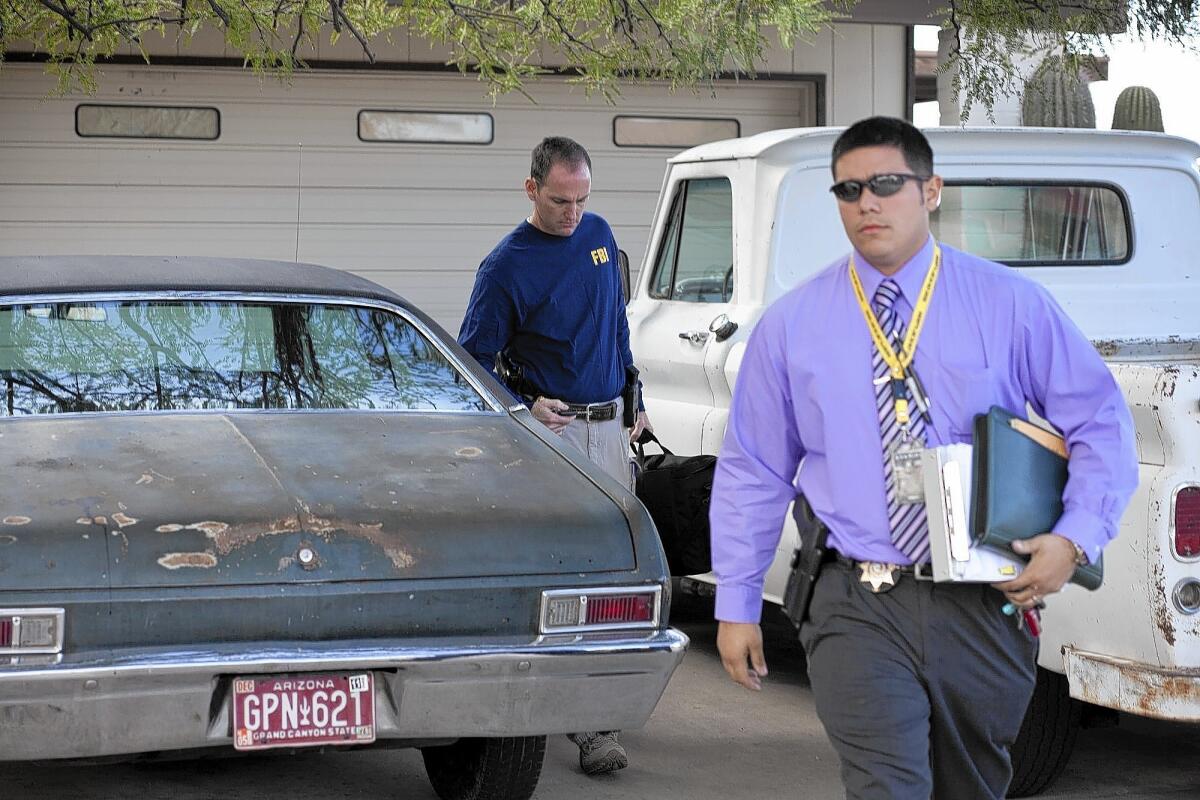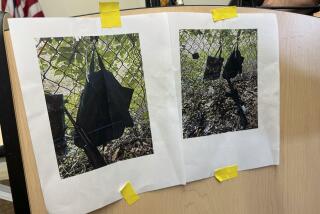FBI files suggest Gabrielle Giffords shooter planned second attack

- Share via
WASHINGTON — Shortly after Jared Lee Loughner shot Rep. Gabrielle Giffords as she met with constituents at an Arizona strip mall, FBI agents rushed to his Tucson residence, fearing it was rigged to explode.
Technicians with bomb-sniffing dogs found the front door locked and blocked by furniture, so they entered through the garage. After searching the kitchen, front room and hallway, they arrived at Loughner’s bedroom, where dogs focused on a small safe behind the door.
Using radiographs to peer inside before opening it, they detected bomb-making components — batteries, a circuit board, wires and a numeric keyboard system. The discovery strongly suggested that Loughner, had he not been captured on that 2011 morning, was preparing for an even more deadly attack.
The new details about Loughner are included in 1,500 pages of FBI investigative files, released this week in response to a Freedom of Information Act request by the Los Angeles Times/Tribune Washington bureau.
To avoid the death penalty, Loughner — whose lawyers initially maintained he was mentally incompetent — pleaded guilty and received a life sentence. With no trial, the FBI files provide what likely will be the public’s only chance to review the federal evidence collected in the case, including Loughner’s love of guns, his eerie rants about semiautomatic weapons, an early encounter with Giffords while he was still in high school and other potential targets.
In one Internet posting, he wrote: “I have a new tattoo on my back: 2 9mm bullets.” He added, “There are important figures in my dreams… Hitler, Hilary Clinton and Giffords to name a few,” he said, misspelling the first name of the then-secretary of State.
His Jan. 8 attack severely wounded the congresswoman and killed six people, including a federal judge and a 9-year-old girl. Thirteen others were injured.
The documents show that Loughner had acquired other weapons and gear, including a 12-gauge shotgun, a 6-inch knife, a tan holster and a box of ammunition. He sometimes loved to show off his arsenal. A longtime friend told the FBI that Loughner visited his home five or six times in the months before the shooting, bragging he had purchased a 9-millimeter Glock for “home protection.”
A former high school friend recalled when Giffords visited Loughner’s class for a question-and-answer session. Loughner raised his hand and asked, “If words could not be understood, then what does government mean?” The room went silent. Everyone in the class, the friend said, felt Loughner “went off the deep end.” Loughner expressed amazement that Giffords did not adequately answer his question, according to the documents.
Agents scooped up reams of details about Loughner’s behavior from former classmates, friends and co-workers, information which the government would have had to turn over to his lawyers as they attempted to mount a case of mental incompetence in the event the case went to trial.
Agents interviewed others who encountered Loughner during his trips to a nearby desert. A Maryland man visiting relatives in Arizona spotted him driving fast and erratically near a shooting range, then slamming on the brakes and sitting in his vehicle, looking “strange.”
On the morning of the shooting, an Arizona Game and Fish Department officer described pulling Loughner over for running a red light. He said Loughner was calm at first, then started crying and then broke out laughing. Though surprised by the odd behavior, the officer let him go.
After he was arrested, Loughner was immediately taken to a federal penitentiary, where guards say he was courteous. On the first day he repeatedly turned down any food, even declining a glass of water. “Thank you, I am fine,” he told agents and guards.
A few days later, driving to his first court appearance before U.S. District Judge Larry A. Burns, Loughner was animated, telling an FBI agent and a federal marshal that he wanted new legal representation. “I’m probably going to throw out my attorney,” he said. Asked whether he felt “sick or injured,” Loughner said, “No.” When questioned about the bruise on his left eye and the scrape down the right side of his head, Loughner answered, “From the events of the 8th, which brought me here today.”
The FBI investigation developed along multiple fronts, documents show. Agents desperately searched for a possible accomplice, tracking down various leads pointing to a neo-Nazi in Indiana, a veteran and others. Eventually the bureau concluded Loughner had acted alone.
Yet top FBI officials, from Tucson to Washington, were deeply worried that what happened in the Safeway parking lot might inspire others.
“Field offices need to be aware of those individuals who may capitalize on the media attention and commit similar acts,” the bureau warned in a high alert to its field offices around the nation. “The most challenging are those individuals who commit acts with no apparent support structure or group affiliation. These lone offenders have proven elusive for law enforcement given their affiliation.”
The agents compiled dozens of pages listing their evidence from the scene of the shooting, including bullet holes in parked cars, torn clothing of the injured and video taken from inside the grocery store.
They interviewed victims and other eyewitnesses, and learned that moments before the attack, Loughner asked Giffords’ district director, Ron Barber, “Where is the congresswoman? … Is that the congresswoman?” Then he stepped around a table set up for the event and shot her. Barber was among those injured and later was elected to her congressional seat.
The documents suggest Loughner’s obsession with Giffords began long before the attack. Agents heard from one tipster who recalled “seeing Loughner at the library on a regular basis watching videos.” The young man “would repeatedly talk loudly to the computer causing a disturbance to others in the area,” the source said. The tipster remembered once “looking over to his computer and noticing he was watching Giffords speeches online.”
Twitter: @RickSerranoLAT
More to Read
Sign up for Essential California
The most important California stories and recommendations in your inbox every morning.
You may occasionally receive promotional content from the Los Angeles Times.











